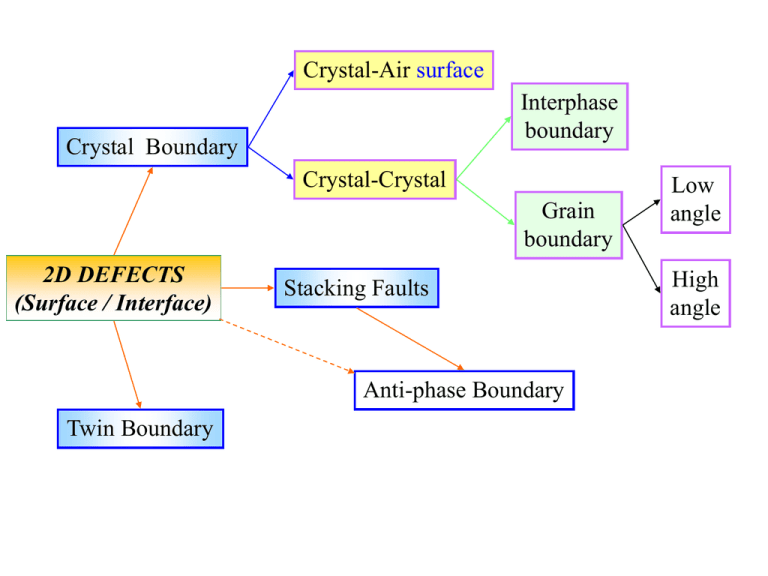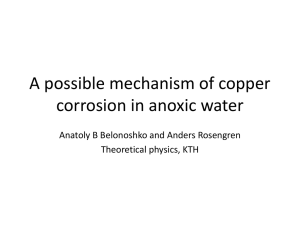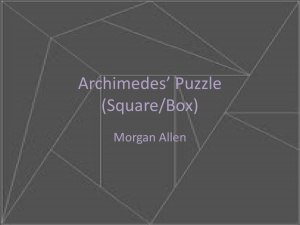
Crystal-Air surface
Interphase
boundary
Crystal Boundary
Crystal-Crystal
Grain
boundary
2D DEFECTS
(Surface / Interface)
Stacking Faults
Anti-phase Boundary
Twin Boundary
Low
angle
High
angle
Low angle
High angle
Based on angle of rotation
Homophase
Based on axis
Based on Lattice Models
Twist
Tilt
Mixed
Special
Based on Geometry
of the Boundary plane
Random
Curved
Faceted
Mixed
CSL/Other
Low angle grain boundaries (misorientation < 10º)
Two extremes
TILT
TWIST
An array of edge dislocations
An array of screw dislocations
Rotation axis lies on the
boundary plane
Rotation axis lies to the
boundary plane
Low angle tilt boundary.
It can be represented by a line of edge dislocations.
Low angle tilt boundary in YBaCuO.
The numbers indicate the number of lattice planes between
dislocations.
Coincidence Site Lattice, CSL
This description is only applicable to certain rotation angles; but
these situations are useful as reference and nature tends to favor
them as well. Rotation by 26.57° (not 36.87°)
Take a 2x1 rectangle
diagonal: 5a,
sides are 2x and x
(5a)2 = (2x)2 + x2
x = a √5
Area of CSL unit cell =
= 5 * area of lattice unit cell
Rotation to Coincidence
• Red and
Green
lattices
coincide
Points to be
brought into
coincidence
S5 relationship
Red and
Green
lattices
coincide
after
rotation of
2 tan-1 (1/3)
Rotation to achieve coincidence
• Rotate lattice 1
until a lattice
point in lattice 1
coincides with
a lattice point in
lattice 2.
• Clear that a
higher density
of points
observed for
low index axis.
[Bollmann, W. (1970). Crystal Defects and Crystalline
Interfaces. New York, Springer Verlag.]
(a) HAADF and (c) ABF images of a [001](210)Σ5 grain boundary in a CeO2 thin film.
Ikuhara Y J Electron Microsc (Tokyo) 2011;60:S173-S188
© The Author 2011. Published by Oxford University Press [on behalf of Japanese Society of
Microscopy]. All rights reserved. For permissions, please e-mail:
journals.permissions@oup.com
(a) HAADF-STEM image, (b) calculated most stable structure, (c) strains and (d) defect
energetics of SrTiO3 [001](310)Σ5 grain boundary.
Ikuhara Y J Electron Microsc (Tokyo) 2011;60:S173-S188
© The Author 2011. Published by Oxford University Press [on behalf of Japanese Society of
Microscopy]. All rights reserved. For permissions, please e-mail:
journals.permissions@oup.com
(a) Most stable atomic structures of SrTiO3 [001](210) Σ5 grain boundary obtained by
theoretical calculation and (b) the corresponding HAADF-STEM image.
Ikuhara Y J Electron Microsc (Tokyo) 2011;60:S173-S188
© The Author 2011. Published by Oxford University Press [on behalf of Japanese Society of
Microscopy]. All rights reserved. For permissions, please e-mail:
journals.permissions@oup.com
(a) HAADF-STEM image of a pristine Σ31 [0001] tilt grain boundary in alumina.
Ikuhara Y J Electron Microsc (Tokyo) 2011;60:S173-S188
© The Author 2011. Published by Oxford University Press [on behalf of Japanese Society of
Microscopy]. All rights reserved. For permissions, please e-mail:
journals.permissions@oup.com
(a) HAADF-STEM image of the Y-doped Σ31 [0001] tilt grain boundary in alumina.
Ikuhara Y J Electron Microsc (Tokyo) 2011;60:S173-S188
© The Author 2011. Published by Oxford University Press [on behalf of Japanese Society of
Microscopy]. All rights reserved. For permissions, please e-mail:
journals.permissions@oup.com
(a) The HAADF-STEM image of the Pr-doped ZnO [0001] Σ7 tilt grain boundary.
Ikuhara Y J Electron Microsc (Tokyo) 2011;60:S173-S188
© The Author 2011. Published by Oxford University Press [on behalf of Japanese Society of
Microscopy]. All rights reserved. For permissions, please e-mail:
journals.permissions@oup.com
The HAADF-STEM image of a Pr-doped ZnO [0001] Σ49 grain boundary.
Ikuhara Y J Electron Microsc (Tokyo) 2011;60:S173-S188
© The Author 2011. Published by Oxford University Press [on behalf of Japanese Society of
Microscopy]. All rights reserved. For permissions, please e-mail:
journals.permissions@oup.com
Coherent tilt boundary in Cu and in CuBi alloy.
Notice that the bright Bi atoms are all located in the grain boundary.
DSC (displacement shift complete) lattice.
Includes every lattice point of both lattices. The finest grid used to
describe grain boundaries.
Shift in the GB can be described as a dislocation in the
DSC lattice. Notice that the lattice sites do not change,
only how far one or the other grain extends changes.
Low angle
High angle
Based on angle of rotation
Homophase
Based on axis
Based on Lattice Models
Twist
Tilt
Mixed
Special
Based on Geometry
of the Boundary plane
Random
Curved
Faceted
Mixed
CSL/Other
Low Index Plane Model
Structural Unit Model
Low Index Model
• Create two surfaces in bulk, A & B
– Energy to do this is gA + gB (+ve)
• Glue them together
– Energy to do this is gAB (-ve)
• Total energy
– E= gA + gB + gAB
– If gA + gB small (low index facets), E is small
Bicrystal Geometry
[010]
S5 36.87º
a
a
Asymmetric boundary
a = 26.57º
Asymmetric boundary
a = 14.04º
Symmetric boundary
Structural Unit Model
• Create two surfaces in bulk, A & B
– Energy to do this is gA + gB (+ve)
• Glue them together
– Energy to do this is gAB (-ve)
• Total energy
– E= gA + gB + gAB
– If gAB small (atoms fit), E is small
– Based upon atoms, not geometry (CSL)
– Not always obvious that these are different
Low angle
High angle
Based on angle of rotation
Homophase
Based on axis
Based on Lattice Models
Twist
Tilt
Mixed
Special
Based on Geometry
of the Boundary plane
Random
Curved
Faceted
Mixed
CSL/Other
From g-plot to EQUILIBRIUM SHAPE OF CRYSTAL → the Wulff construction
Draw radius vectors from the origin to intersect the Wulff plot (OA in Figure)
Draw lines to OA at A (line XY)
The figure formed by the inner envelope of all the perpendiculars is the
equilibrium shape
Twins in Pt
Faceting
Plane
Silicon
\









